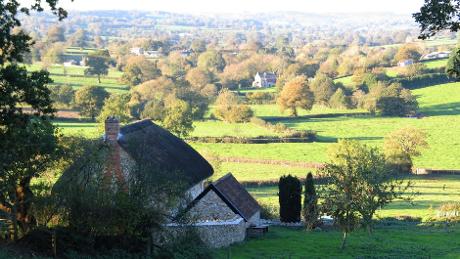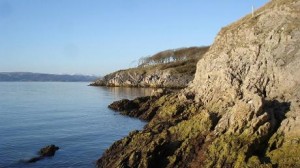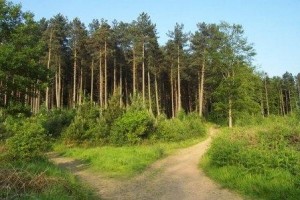
Loughwood Meeting House, Devon in the Blackdown Hills AONB - © National Trust
Blackdown Hills – Area of Outstanding Natural Beauty (AONB) is located in the counties of Devon and Somerset in south west England. Designated a AONB back in 1991, the AONB covers 370 square miles along the Devon and Somerset border. The area is known for its scenic English countryside with springs, steep ridges, high plateau and valleys; offering visitors with beautiful countryside views with a number of charming villages and farms located within the AONB.
The area is popular for walkers, cyclists and horse riding with a number of routes to explore. Visitors can enjoy the wildlife, scenic villages, tranquilly of the countryside and the scenic landscape.
Attractions
Blackdown Hills AONB is located within the English counties of Devon and Somerset, the area offers visitors impressive natural scenery and a place to enjoy the great outdoors and the scenic English countryside. The actual area covered under the AONB is roughly from Wellington in the north to Honiton in the south and from Chard in the east to Cullompton in the west, with the M5 motorway located to the north and west of the boundary.
The north of the area is noted for its wooded scarp face; whilst the south of the area the land transforms to a plateau that includes a number of valleys home to a number of hamlets and villages. The special qualities relating to the areas landscape, wildlife and cultural heritage make the Blackdown Hills a special place.
The area has a rich history, cultural heritage and is of archaeological value with a number of historic sights.
The AONB is unusual in that there are no cities or major towns in the area, there are a number of charming villages and hamlets. Local accommodation includes a mix of hotels, cosy B & B’s, Guest Houses, Self Catering houses and cottages, there is accommodation available in the nearby towns of Taunton, Chard, Honiton and Cullompton.
Visitor attractions in the area include Coldharbour Hill located in the Devon village of Uffculme. The mill was originally built back in 1799 to spin woollen and worsted yarns; the mill provides a fine example of industrial Georgian architecture and industry. The mill has been a museum since 1982 and visitors can learn more about the fascinating history of the mill in the guided tours that will show the range of power sources, exhibitions, Victorian mill conditions and much more.
Dunkeswell Aerodome is located in east Devon, the former airbase was used during World War II by the US Air Force and then by the RAF. The historical airbase includes a number of period buildings and structures dating back to that era.
Dumpdon Hill Fort is located a few miles from Honiton, the Iron Age hill fort is located on one of the largest hills in the scenic Otter Valley, visitors climbing the hill will be rewarded with some inspiring views over the surrounding areas. The fort is currently managed by the National Trust.
Hese Moor is a Site of Special Scientific Interest (SSSI) that is both owned and managed by the Luppitt Commoners Association. Located close by to Honiton, Hense Moor is a favourite for nature lovers along with wildlife enthusiasts; the moor supports a range of wildlife, the site is assessable via public footpath. The sites importance has been reaffirmed with its SSSI accreditation ensuring the natural beauty of the area is maintained and protected.
Loughwood Meeting House is located close by to the village of Dalwood in Devon, a few miles from Axminster. The house dates back to the 17th century and is one of the oldest remaining Baptist churches in England and is known for its thatched roof. The beautiful chapel is located on a hillside offering some splendid views over the rolling Devon countryside and across the Axe Valley. Inside the chapel visitors can see a place of worship that has altered very little since the 18th century. Visitors can see the musicians’ gallery and pews and pulpit, the site is managed by the National Trust.
Visitors can enjoy a trip to the Blackdown Hills AONB; the fine scenery, countryside and the lack of towns and cities ensures peace and tranquillity whilst showcases many of the finest characteristics of the English countryside.
How to Get There
The Blackdown Hills are accessible by both car and public transport.
By Car:
Cullompton in Devon is a town located close by to the AONB, it is located approx 180 miles from London. From London, take the A4 then M4 motorway up to junction 20, then take the M5 motorway. At junction 28 of the M5 exit on to the A373, then take the B3181 towards Cullompton. The approx journey time is 3 hours 15 minutes to 4 hours depending on time of day and traffic conditions.
By Train:
The train station at Honiton is on the west of England mainline and there are there are regular train services from London Waterloo station, the journey time is approx 3 hours.
By Bus/Coach:
There are regular buses available from London Victoria Coach station to Exeter in Devon, from Exeter there are services available to Honiton; the journey time is approx 5 hours 45 minutes to 6 hours 15 minutes depending on time of day and traffic, services are provided by services are provided by National Express.
Contact Details
Blackdown Hills AONB
St Ivel House
Hemyock
Cullompton
Devon
EX15 3SJ
Telephone: +44 (0)1823 680681
email:blackdownhills@devon.gov.uk
Website: Blackdown Hills AONB
Map
View Larger Map
For Local Search and Directions see: Blackdown Hills (AONB) Map
Tips & Other Considerations
The weather and climate can be unpredictable, there can be elements of all four seasons in one day. Ensure you check the weather forecast before you travel and have the correct clothing and footwear including comfortable walking shoes, fleece, raincoat and umbrella.
Follow travel advice and remain alert, vigilant and aware of your belongings at all times especially your wallet/purse and valuables and ensure they are hidden away from public view. If you have a bag try to use a shoulder bag with a good quality, strong strap, that is put across your shoulder not on your shoulder making it more difficult for anyone to take your bag.
If you are travelling by car to Blackdown Hills ensure you are well prepared with maps and Sat Nav to aid your journey, particularly if you are not familiar with the local area and roads. Use the journey planner for door to door directions. Check traffic updates before you travel.
If you are looking for car parking in and around the AONB, ensure you fully understand the rules, regulations & charges for car parks and street parking. The rules & regulations can be complex & confusing if you are unclear, it is wise not to park there.
If you are travelling by public transport, check for service updates prior to beginning your journey for any delays, disruption or cancellations to services that may impact on your journey. Ensure you have the service timetables for the trains, trams, buses and coaches. Remember when the last services are and ensure you make it to the train/bus/coach stops well in time to avoid missing the service.
Disclaimer: The information given in on this website is given in good faith and to the best of our knowledge. If there are any discrepancies in no way do we intend to mislead. Important travel details and arrangements should be confirmed and verified with the relevant authorities.




